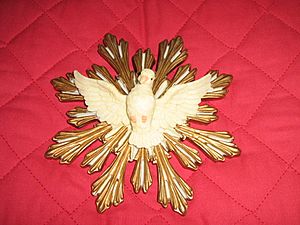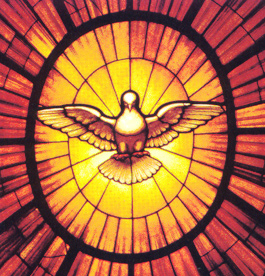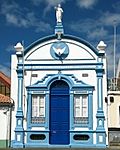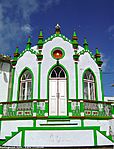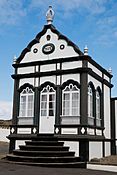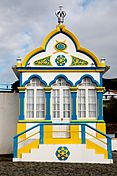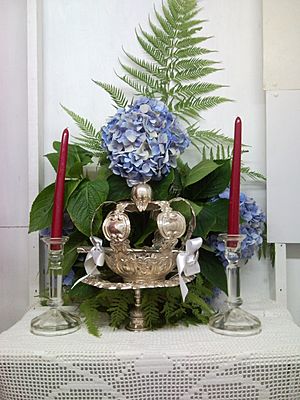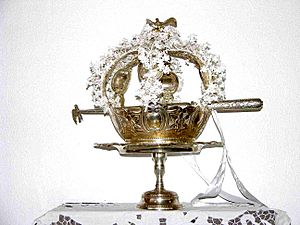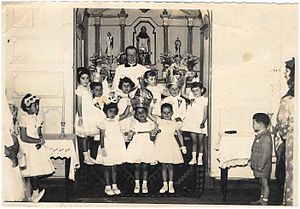Cult of the Holy Spirit facts for kids
The Cult of the Holy Spirit (Portuguese: Culto do Divino Espírito Santo) is a special religious tradition. It's also known as the Cult of the Empire of the Holy Spirit (Culto do Império do Divino Espírito Santo). This tradition is inspired by Christian ideas about a future age of peace. It's strongly linked to the Azorean Catholic identity.
This cult includes unique symbols, buildings, and religious practices. These traditions are still very much alive in the Azores. They are also found in many places where Portuguese people have settled. This includes parts of Brazil and Portuguese communities in North America. The Cult of the Holy Spirit involves traditional rituals and celebrations.
The word "cult" here means an accepted religious practice. This is different from how the word is often used today. Devotion to the Holy Spirit is a part of traditional Catholic beliefs. Many Catholic groups are inspired by it. However, the Cult of the Holy Spirit has its own special features.
Contents
History of the Holy Spirit Cult
Early Ideas: Joachim of Fiore
The idea of worshipping the Holy Spirit was promoted by a prophet named Joachim of Fiore. He lived a long time ago and died in 1202. Joachim believed that a "Third Age" would begin around the year 1260. This new age would be guided by the Holy Spirit. He thought that the Church's usual structure wouldn't be needed. He also believed that people of all faiths would unite. These ideas became popular with a group within the Franciscan Order. However, these theories were later not accepted by the Church.
How the Cult Grew
About 200 years later, these ideas became popular again in the Azores. Their religious practices, rituals, and symbols spread across the islands. They have continued to this day. Franciscan spiritual leaders greatly influenced these acts of faith. They were the first religious group to settle in the Azores. They brought traditions that were fading in mainland Portugal.
In the isolated communities of the Azores, life was often uncertain. People faced many challenges. Because of this, the Holy Spirit's rituals were welcomed and grew strong. The Azores became the last places where Joachim's ideas were widely practiced.
We don't know exactly how the modern cult and its rituals started. A popular idea is that Queen Elizabeth of Portugal brought these celebrations to Portugal. A main center for this devotion was in Tomar. This was also where the Order of Christ was located. This order was in charge of the spiritual life in newly discovered lands like the Azores.
Another important center was Alenquer. In the early 1300s, Queen Elizabeth started the first celebration of the Império do Divino Espírito Santo. This means "Empire of the Divine Holy Spirit." She was likely influenced by Franciscan spiritualists. From there, the cult spread in Portugal. Later, it traveled with the Portuguese during their explorations across the Atlantic.
The new colonies, including the Azores, were first overseen by the Order of Christ. This order appointed new priests and guided the faithful. They supervised religious development. References to the Holy Spirit cult appeared early and widely across the Azores. An old writer named Gaspar Frutuoso noted that this devotion existed on all the islands. The Order of Christ allowed, and even encouraged, its spread.
The first groups called Irmandades do Divino Espírito Santo (Brotherhoods of the Divine Holy Spirit) were noted in the 1500s. The first hospital in the Azores (built in 1498) was named Hospital do Santo Espírito. Giving out food like meat, bread, and milk was already an important charity practice in the mid-1500s.
From the 1700s onwards, the Holy Spirit cult became very important in Azorean culture. It helped unite people across the islands. When Azoreans moved to other places, they took the cult with them. By the late 1700s, there were feast days in Rio de Janeiro and other parts of Brazil. In the 1800s, these traditions spread to places like Massachusetts, Rhode Island, and California in the United States. They also reached Ontario, Quebec, and British Columbia in Canada.
The Feast of the Empire of the Divine Holy Spirit was even celebrated on ships. These ships were sailing to Brazil and India in the 1500s. A Jesuit missionary named Fulvio Gregori wrote about a celebration on a ship. He said the Portuguese would choose a boy as "Emperor" for the Feast of Pentecost. They dressed him richly and gave him a crown. They also chose "lords" and "officers" to serve him. Even the ship's captain and pilot joined in. On Pentecost, they held a special Mass on the ship's bow. The Emperor sat on a velvet chair with his crown and scepter. Music, drums, and cannons added to the celebration. After the feast, everyone on board, about 300 people, was served food.
Main Beliefs of the Cult
The Cult of the Holy Spirit has several key beliefs that guide its followers. These ideas come from the teachings of Joachim of Fiore:
- Hope (Portuguese: esperança) — Followers believe in a future time of spiritual growth for humanity. They see the Holy Spirit as the source of all knowledge and order.
- Faith in the Divine (Portuguese: Fé no Divino) — People believe the Holy Spirit is everywhere. It knows and sees everything. They feel that there are no secrets from the Holy Spirit. They also believe that promises made to God must be kept. Seven spiritual qualities guide the followers: wisdom, understanding, counsel, strength, knowledge, piety, and fear of the Lord.
- Egalitarianism — This means everyone in the brotherhood is equal. Anyone can become a mordomo (leader of the brotherhood). Everyone can also be crowned as the "emperor" during rituals. When someone is the "emperor," they receive equal respect. This shows the idea that all people are equal in the eyes of the Holy Spirit.
- Solidarity and Charity — This involves giving food (like meat, soup, and milk) to those in need. Poor people are especially helped and take part in the celebrations. Everyone forgives each other to welcome the Holy Spirit.
- Independence from the Church — The Holy Spirit cult does not rely on the Church's formal organization. Priests are not needed for the practices. There are no go-betweens between the followers and the Divine. Over time, the Church has become more involved. Priests often bless the events and hold masses for the feast.
Impérios: Special Buildings
The way the cult is organized varies a bit between islands. But it generally includes these structures:
Irmandade: The Brotherhood
The Irmandade (English: Brotherhood) is the main group of the cult. It includes "brothers" who join voluntarily. Everyone in the brotherhood has equal rights and duties. In the past, only men were part of these groups. But now, both women and men are accepted. People from different backgrounds can also join. Each irmandade is a local group. It brings together families and residents from a specific area. These groups have unwritten rules that everyone understands and follows. If Church leaders or authorities try to interfere, members usually resist.
Império: The Cult Building
Each irmandade is centered around the Império do Divino Espírito Santo. This is usually a small building with a unique architectural style. Here, followers perform their rituals. The look of these Impérios changes from island to island. Some are simple buildings with tiled roofs, like in Santa Maria. Others are grand chapels with fancy fronts and a crown on top, like in Terceira.
The Império is used to store special religious items like crowns and flags. It's also where food offerings are cooked and given out. Some religious services related to the event happen here too. Permanent impérios started appearing in the late 1800s. This was probably due to money sent by Azorean immigrants from Brazil or California. Before this, the cult used temporary structures called treatros. These were built for the events and then taken down. Azorean communities in places like New England and Canada built larger indoor halls. This was because of the different weather conditions there.
Mordomo: The Event Organizer
During each celebration, one member of the brotherhood is chosen as the mordomo. This is usually done by drawing names. Sometimes, a young child picks the name. Many brotherhoods also allow people to volunteer. This happens when a brother makes a promise to the Holy Spirit. This promise requires an act of kindness and charity.
The mordomo is in charge of many things. They collect money for the feast and organize the entire event. They decide who to invite and buy things like meat, bread, and wine. The mordomo is seen as the main leader of the brothers during the celebration.
Symbols of the Holy Spirit Cult
The cult's rituals use various symbolic objects. These are important parts of the ceremonies:
- Crown, scepter, and orb — These are the most important symbols of the Império. They are central to the celebrations. The crown is imperial in design, made of silver. It usually has four arms that meet at a golden orb. On top of the orb is a dove, representing the Holy Spirit. Each crown comes with a silver scepter, also topped with a dove. The crown and scepters are decorated with white ribbons. They are placed on a tall silver stand. The size of the crown varies. Most brotherhoods have one large and two smaller crowns. These represent the Empire of the Holy Spirit. Carrying the crown or having it in your home is a great honor. The crown moves from house to house among the brotherhood members. It stays in a place of honor in the home, where prayers are said nightly. In the past, moving the crowns involved a big procession. Today, it's usually simpler.
- Flag — The flag is bright red and square-shaped. It has a white dove of the Holy Spirit in the center. Golden and white rays spread out from the dove. The flagstaff is made of wood, about two meters tall. It has a dove made of tin or silver on top. The flag is always with the crown during ceremonies and coronations. It's an honor to be chosen to carry the flag in the procession. A smaller flag is often raised near where the crown is kept. White flags are also commonly seen in squares during the ceremonies.
- Hymn — The Hino do Espírito Santo (English: Hymn of the Holy Spirit) was composed in the late 1800s. Bands play it, and people sing it during crowning ceremonies. Some parts of this hymn have even been included in the Hymn of the Azores, which is the regional anthem.
- Mace and ribbon — These are inspired by the ceremonial staffs carried by old judges. The ceremony and procession include a number of mace-bearers, usually 12. The wooden maces are about 1.5 meters long. Some have a base for a candle or a tin/silver dove on top. During the procession, the mace-bearers surround the person carrying the crown. Sometimes, the maces are joined to form a rectangle, and the crown-bearer walks inside it. In some brotherhoods, an extra mace is given to someone who keeps the procession in order. This mace is sometimes called the "pig incentive" because it might have been used to clear animals from the streets long ago. Young people are often chosen for this honorable role.
- Foliões do Divino — This is a small group of about five musicians. They sing hymns and play drums, cymbals, and tambourines. They visit the homes of the brotherhood members. They also take part when the crown is moved, when donations are collected, during processions, rituals, and when offerings are given out. On Santa Maria and parts of São Jorge, the foliões are part of more complex rituals. These rituals are not common on other islands anymore.
Rituals and Celebrations
Procession: The Big Move
This is also called the cortège, império, or mudança (English: the move). On Easter day, the crowns are taken to the church. They stay on the altar until the end of the service. Then, the chosen person is ceremonially crowned. This is called the coronation. The "emperor" then goes to their home. They are joined by their procession and the brotherhood. The Holy Spirit's flag leads the way. The foliões musicians are also there. The crowns are surrounded by poles, forming a rectangle. The faithful follow behind.
Often, a band plays cheerful music during the procession. Sometimes, only the Foliões of the Divino accompany them. When they reach the emperor's home, the crowns are placed on a special altar. This altar is made of wood and decorated with white paper and flowers. The crowns stay there all week. Every evening, neighbors and community members gather at the home. In the past, there might have been food and dancing. Now, it usually ends with prayers and blessings to the Holy Spirit.
On the next Sunday, the crowns go back to the church with the procession. The local priest welcomes them and recites a special blessing. This process traditionally repeats for seven Sundays after Easter. The seventh Sunday is called Domingo do Bodo. Sometimes, it continues until the eighth Sunday. Today, influenced by religious immigrants, the tradition is shorter. It often includes a brief procession on the day of the coronation. Ceremonial transfers of the crown to the emperor's home happen throughout the summer.
Coronation: The Crowning Ceremony
The coronation (Portuguese: coroação) is the main religious ceremony. During this, the silver crown is placed on the head of the "emperor" by the parish priest. After ritually kissing the dove on the silver scepter, people are allowed to hold the crowns. Blessings are given in the name of the Holy Spirit, and the hymn is played. Right after this ceremony, the procession leaves the church. The priest sings a blessing again.
Bodo: Sharing the Blessings
Traditionally, on the seventh Sunday after Easter (which is Pentecost Sunday), the faithful hold the bodo. On this day, the procession leaves the church and goes to the império. The Holy Spirit's flag and the crowns are displayed there. In front of the império, on long tables, offerings are placed. These offerings are blessed and then given out to the people gathered.
The brotherhood welcomes everyone. They invite them to freely enjoy bread and wine. Meat, sweet pastries, and massa sovada (a traditional Portuguese sweet bread) are also offered. The mordomo organizes all of this. At the end of the Bodo, the crowns are collected. The procession then takes them to the mordomo's home. The Monday after this seventh Sunday of Easter is Azores Day. It's also known as the Dia da Pombinha (English: Day of the Dove).
Esmola: Charitable Gifts
The esmola or pensão (English: charitable offering) is made up of beef (from an animal killed specifically for the event), bread, and vinho de cheiro. This is a special wine made from Isabel grapes. These gifts are given to the brotherhood members and to families who need help the most.
Função: The Community Meal
The function is a gathering of neighbors, family, and friends for a special meal. It includes guests invited by the person who made a promise to the Holy Spirit. The meal features "Holy Spirit Soup." This is a meat broth poured over buttered bread and flavored with mint leaves. It's served with the cooked meat used to make the soup, Portuguese sweet bread, and sweet rice pudding sprinkled with cinnamon. There are many ways to make the soup. On Terceira island, for example, the Holy Spirit Soup is served with alcatra. This is a meat dish cooked in red wine in an earthen pot. The function shows community sharing. It happens with the crowns and flag present, and hymns to the Holy Spirit are sung, often led by the Foliões.
Today, these functions are also held outside the usual religious context. They happen on Azores Day, during official receptions, or as tourist events to promote Azorean culture. The largest recorded function took place on June 10, 2000. 8,000 people gathered in Angra do Heroísmo. Many important leaders were there, including the President of Portugal.
Briança: The Cow Procession
Before the main meal, a procession goes through the community with a cow. This cow will later be used for the feast. It's decorated with colorful paper flowers. The foliões musicians accompany it. This procession, which happens before the coronation and Bodo, stops at the door of each family who donates money. Hymns and chants are sung, and traditional briança music is played.
Ceia: Dinner for Donors
The ceia dos criadores is a dinner held to honor farmers. These farmers have donated animals for the meal or given other gifts to the brotherhood. Like the briança, this event helps raise money for the celebrations. Important community figures and local politicians are traditionally invited.
|


